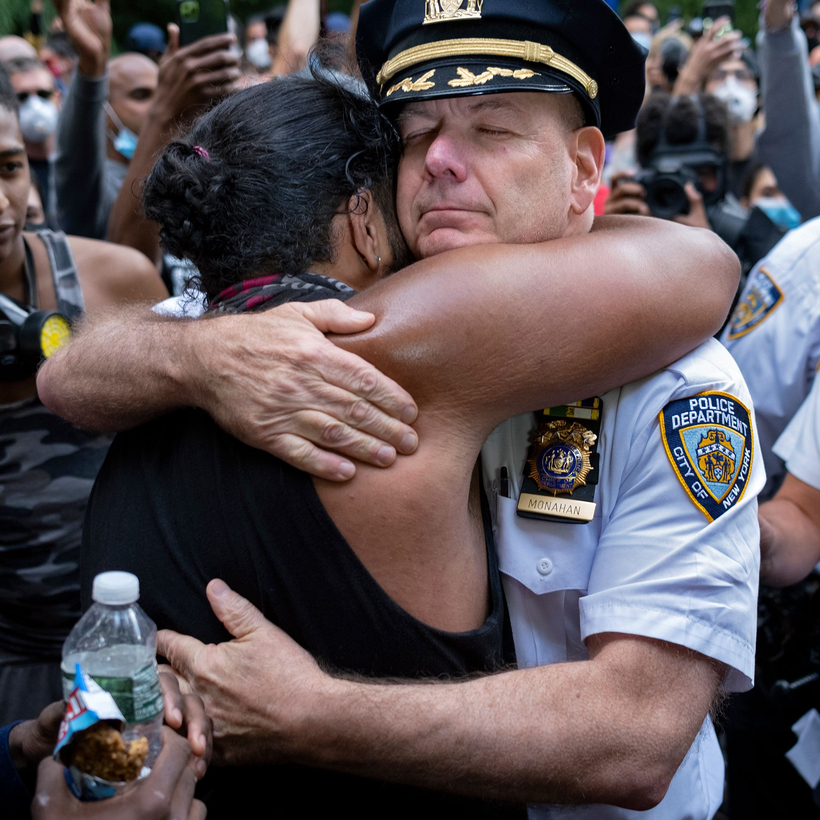These days, you might think that the only way to fight crime is with the police.
Following years of unprecedented peace—with New York City having the lowest crime rate and lowest incarceration rate in its history—shootings doubled during the pandemic compared to 2019, part of a sharp rise in violent crime across the country. In response, President Biden and Mayor Eric Adams both issued crime-fighting plans which nod to law-enforcement and community investments.
But the theater of politics demands that police get the spotlight. Biden came to New York to hold a summit on gun violence and appeared at police headquarters, a blue wall of officers swallowing up the civilian guests of honor.
In the face of some horrific crimes—the fatal shooting of two police officers, a fatal push off a subway platform—Eric Adams, the city’s new mayor, has tipped toward talk of more police, in more places, more of the time.
Activists on the New York City Council and in the nonprofit sector have a different take. This group, which includes many who favor abolishing both police and prisons, fears that the increase in shootings will be used as an excuse to double down on law-enforcement approaches as the city seeks to restore order to the streets.

To them, New York City is not a remarkable example of a decades-long drop in crime and incarceration—it is a horror show, ground zero for an unconstitutional stop-and-frisk policy, racist broken-windows policing, and a train-wreck penal colony on the outskirts of town called Rikers Island.
How do we get out of this ever escalating narrative war that seems destined to ricochet in the echo chambers of social media until the end of time?
As refugees from the two warring camps, we believe we can offer a way out.
Elizabeth made her bones going after street crews in the city in the 1990s as a federal prosecutor. Her service, which included advising the former mayor of New York City Bill de Blasio and ex-governor Andrew Cuomo, made her sympathetic to the abolitionists, but has also tugged her back to a belief that government can be a force for good.
How do we get out of this ever escalating narrative war that seems destined to ricochet in the echo chambers of social media until the end of time?
Greg is a product of the progressive nonprofit sector. He has spent his career critiquing the justice system and attempting to implement crime-prevention and alternative-to-incarceration programs while the head of the Center for Court Innovation.
Despite our different trajectories, we have arrived at the same conclusion: there is a need for practical strategies to advance public safety that are deeply grounded in the facts on the ground, not the latest ideological bumper stickers.
For example, the facts tell us that, despite all of the theatrics, we are nowhere near the bad old days in terms of violence. When it comes to shootings, we are, roughly speaking, where we were under Mayor Bloomberg in 2011, not at the heights of bloodshed of the early 1990s, when New Yorkers regularly murdered each other at a rate close to five times that of today.
Nonetheless, the facts also demand that we respond urgently to the doubling in shootings in the past two years. Violence does not just destroy families; it affects school achievement, jobs, and every part of urban life. And there are profound inequalities in who is paying this toll; in New York City, young Black men are shot at more than 80 times the rate of young white men.

The facts point us toward a third way to make our cities safe and vibrant: mobilizing the whole array of civic services—not just police—to produce enduring safety and thriving communities.
Together, we have launched a new organization called Vital City, which charts a path between the raindrops of the left and right. Through a policy journal, special reports, and other products, we hope to offer engaging and understandable facts, trenchant insights from across a spectrum of views, and actionable strategies for strengthening the social fabric.
We intend to shift the center of gravity of the debate about safety in New York and other cities. The operative question is not whether we should have “more cops or fewer cops” but rather how to mobilize all of the resources that make a vital city—of which police services are but one—to reduce crime and increase well-being.
We have enlisted leading scholars, practitioners, and community leaders as well as data scientists and graphic designers to make new information and new ideas as accessible as possible. In the days ahead, our team of contributors will focus on answering a set of pressing questions: Are we using public spaces to good effect? What should we be doing about deteriorating quality-of-life conditions in our neighborhoods? And how can police work with the community to become trusted partners?
Underlying all of this work is our core belief—rooted in the evidence—that it is the informal and unspoken agreements among neighbors that truly ensure safety in our neighborhoods. Civic services—better street lighting, clean parks, summer jobs for teens—are essential components to sustainable safety. We think that the lion’s share of city residents agree with us: at the end of the day, nothing stops a bullet like a job.
Elizabeth Glazer and Greg Berman are the co-editors of Vital City. Glazer worked as the justice adviser for a New York governor and mayor, and earlier as a federal prosecutor. Berman is the distinguished fellow of practice at the Harry Frank Guggenheim Foundation. His latest book is Start Here: A Road Map to Reducing Mass Incarceration (The New Press)

